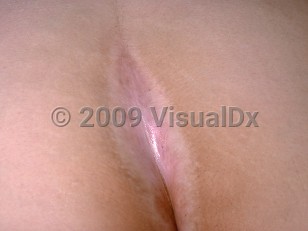Lichen sclerosus - Anogenital in
See also in: Overview,External and Internal EyeAlerts and Notices
Important News & Links
Synopsis

The main symptom is pruritus, and at times, this can be incapacitating, interfering with daily activity and sleep. Dyspareunia and urinary retention may occur. It can also be asymptomatic, just with scarring and hypopigmentation.
Squamous cell carcinoma (SCC) can occur within LS genital lesions. There is a higher risk of SCC in untreated cases.
Codes
L90.0 – Lichen sclerosus et atrophicus
SNOMEDCT:
895454001 – Lichen sclerosus
Look For
Subscription Required
Diagnostic Pearls
Subscription Required
Differential Diagnosis & Pitfalls

Subscription Required
Best Tests
Subscription Required
Management Pearls
Subscription Required
Therapy
Subscription Required
Drug Reaction Data
Subscription Required
References
Subscription Required
Last Updated:01/18/2022
 Patient Information for Lichen sclerosus - Anogenital in
Patient Information for Lichen sclerosus - Anogenital in - Improve treatment compliance
- Reduce after-hours questions
- Increase patient engagement and satisfaction
- Written in clear, easy-to-understand language. No confusing jargon.
- Available in English and Spanish
- Print out or email directly to your patient



